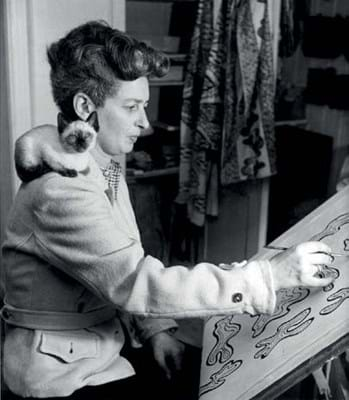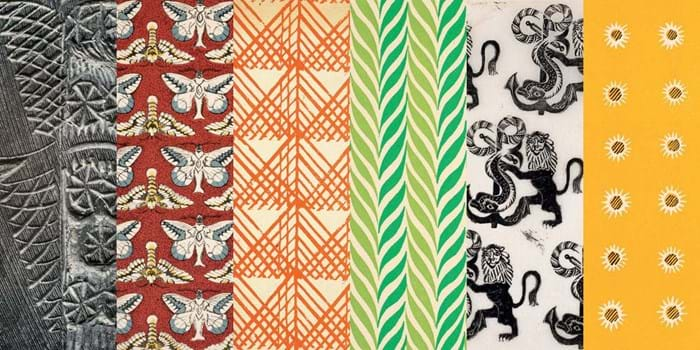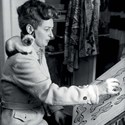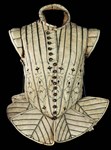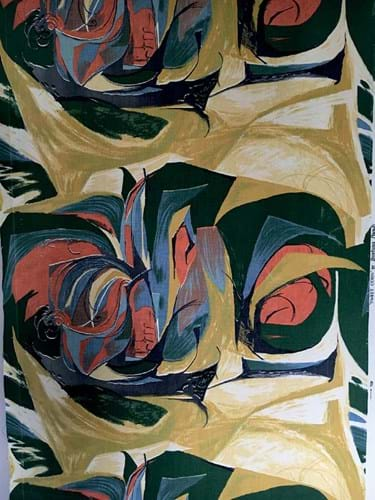
Meg Andrews has been a textiles dealer for 30 years, before which she set up Sotheby’s costume and textile department.
She buys rare and unusual antique costumes and textiles and has been a consultant to the National Trust and assorted Heritage Lottery Memorial Fund purchases, including the deal last year involving TE Lawrence’s robes for the Imperial War Museum in London.
Andrews is also a long-time trustee of the Textile Society, which runs biannual antique and vintage textile fairs: one in Manchester, the other in London at Chelsea Town Hall, with the next on October 13.
On her website Andrews the dealer has a section of 20th century textiles including two lengths in the Chequers design by Terence Conran, created in 1949 when the man now described as a design legend was still a student. Also available is a textile by Barbara Brown, who studied at the Royal College of Art from 1953-56. With strong colours and a bold design this 1950s half-width piece is pictured above.
Brown is known for her strong geometric award-winning designs from the 1960s and ‘70s produced chiefly for Heal Fabrics, a subsidiary of Heal & Son, which specialised in well-designed contemporary fabrics.
This 6ft 10in x 2ft 1in (2.1m x 63cm) piece, marked Barbara Brown Sweet Corn on the selvedge (the ‘self-finished’ edge of fabric, keeping it from unravelling and fraying), costs £90.
Flower Power
The former owners of Luna, a vintage shop in Nottingham, now concentrate on their mid-century fairs.
Virender and Paul Rose hold the next one on Saturday, June 23, and among the 60 dealers who will stall out in marquees and on the outside lawns at Nottingham Rugby Club is Christine Boydell. The former university lecturer, who taught design history, now deals in mid-century fabrics and textiles as Festival of Pattern.
Among the stock she will be bringing to the fair is a spun rayon curtain length, 2ft 9in (84cm) long x 3ft (91cm) wide. In the Flowerpot pattern and priced at £25, it is a piece created by Tom Mellor in 1954 for the textile company David Whitehead, now based in Wigan.
In the 1950s and ‘60s this firm was at the forefront of selling fabrics designed by the UK’s leading designers including Terence Conran and Marian Mahler. A few of these early designs by these leaders in their field are available from the company today.
The fair is held at held at the club in Lady Bay, near Nottingham. Plenty of variety is on offer including homewares from Homeward Home, plus lighting, 20th century ceramics, architectural salvage, midcentury furniture and textiles.
festivalofpattern.wordpress.com
Displays double up
Textiles are in the spotlight with two exhibitions currently running in London. Orla Kiely: A Life in Pattern is at the Fashion and Textile Museum in Bermondsey, while Enid Marx, a woman once hailed as ‘Britain’s queen of patterns’, has the first show in 40 years dedicated to her work, at the House of Illustration in north London. Both end on September 23.
Designer Kiely, whose retro-inspired prints are all over kettles and cushions in many a home has – along with other contemporary textile designers – a debt to printmakers including the famed Lucienne Day and the far less well-known textile designer, printmaker and illustrator Enid Marx (1902-98).
Known to her friends as Marco, Marx, a second cousin of Karl, was a contemporary of Eric Ravilious and Edward Bawden and from an early age was always passionate about patterns. She amassed a huge hoard of decorative objects including gingerbread moulds, cigarette cards, and of course, fabrics.
During the 1930s Marx created the block print geometric designs used on the seating in London’s tube trains and produced wood-engraved book cover prints for Curwen Press.
In the Second World War she worked on utility fabrics, creating 30 upholstery and curtain fabric in cheery designs.
Among the 150 pieces of Marx’s work on show over a career which spanned seven decades are her posters for the London Zoo, as is her other work showing her love of drawing animals, particularly Siamese cats.
The show’s co-curator Olivia Ahmad said: “Enid Marx was a pioneering designer whose interests in modernism and popular art traditions inspired great achievements in textile design, book illustration and printmaking.”
Following her death in 1998 aged 95, one of her obituaries described Marx as charming, industrious, a perfectionist, outspoken and wilful. As an example of the so-called wilfulness, she was sacked from working on a secret job during the war when she asked for more paper for doodling.
Enid Marx: Print, Pattern and Popular Art runs at The House of Illustration in London N1. This gallery is the UK’s only public gallery solely dedicated to illustration and graphic art.



